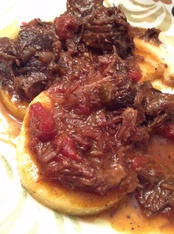WINE WITH…Braised Beef Cheeks
Melt-in-your-mouth deliciousness is what beef cheeks can provide. If you like braised short ribs, you will love beef cheeks too, as they offer the same sort of rich, meaty flavor that just screams out for red wine.  Cheeks are thick muscle meat (think of how the cow works those muscles all day long chewing grass), so they need a long, slow braise to achieve the meltingly tender state that makes this dish such a standout.
Cheeks are thick muscle meat (think of how the cow works those muscles all day long chewing grass), so they need a long, slow braise to achieve the meltingly tender state that makes this dish such a standout.
Beef cheeks are not yet a staple in the meat section of your market or even at your regular butcher shop. You may have to special order them; but remember when you used to have to do that with short ribs? These days, now that they’ve become so popular, short ribs are almost ubiquitous and wildly expensive. So do cook up some beef cheeks before the same thing happens to them!
Beef cheeks improve in flavor if made up to 2 days in advance.
Serve them with polenta, egg noodles, or rice.
Braised Beef Cheeks
(serves 6)
6 beef cheeks (about 4 pounds), trimmed of excess fat
salt and pepper
6 tablespoons olive oil (divided use)
1 medium onion, minced
1 shallot, minced
2 medium carrots, finely chopped
1 rib celery, finely chopped
1 clove garlic, minced
2 teaspoons unsweetened cocoa powder
3 cups dry red wine
2 28-ounce cans whole tomatoes, chopped (juice included)
1 teaspoon thyme
1 bay leaf
Preheat oven to 325°
Pat beef cheeks dry and season with salt and pepper. Heat 3 tablespoons of the oil in a large, heavy ovenproof pot. When oil is hot, but not smoking, add the meat and brown it on all sides (about 10-15 minutes total). Transfer meat to a bowl. Discard the oil, wipe the pan out with a paper towel, and add the remaining oil to the pan. Add the onion, shallot, carrot and celery, and cook over medium heat, stirring occasionally, about 5 minutes. Add the garlic and continue cooking another 5 minutes or so, or until the vegetable have softened. Stir in the cocoa powder and the wine. Over high heat, cook the mixture until it has reduced by about half (about 10 minutes).
Return the meat to the pan along with any juices that may have collected. Add the tomatoes and their juice, the thyme and bay leaf. Season with salt and pepper. Transfer the pot to the oven and cook, covered, for about 3 hours, or until the cheeks are very tender.
This dish demands a fruit-filled red wine. It’s so flavorful that delicate or subtle wines are likely to lose their appeal. Instead, choose something that fairly bursts with bright, ripe, fleshy flavor. With one exception, our favorites among the twelve wines tried were Californian, which is no surprise considering that the Golden State excels with red wines that display just this sort of exuberant character. Interestingly, more earthy French or Italian wines did not perform as well. That’s because the dish itself is so meaty and deep that it needs the bold energy of a fruit forward wine as a complement.
|
Selection
|
Approx. Price |
Comments |
|
Dry Creek Vineyard, Sonoma County (California) Zinfandel “Heritage Vines 2011
|
$19 |
A rich, ripe but in no sense excessive Zinfandel, with plenty of briary, brambly fruit flavor, and enough depth to hold up to even a hearty dish like this one. It outperformed a more refined Zin costing nearly three times as much.
|
|
Louis Martini, Alexander Valley (California) Cabernet Sauvignon 2010
|
$30 |
Full-flavored, with pliant but notable tannins, this Cabernet excelled with the beef cheeks. It might seem almost too fruit-forward if sipped on its own, but it made the pairing really shine.
|
|
Nickel & Nickel, Napa Valley (CValifornia) Merlot “Suscol Ranch” 2010
|
$53 |
Tasting a wine like this should convince any true wine lover that Merlot is back. Forget the thin, candied reds of years past. This superior offering has all the depth and red fruit flavor anyone could want, yet feels soft and seductively supple on the palate. Much like the beef cheeks, it melts in your mouth.
|
|
Pujanza Hado, Rioja (Spain) 2010 (Imported by Grapes of Spain)
|
$20 |
Internationally styled, meaning that it emphasizes the taste of fruit before anything else, this is a classy Rioja, with cherry flavors, hints of spice, and a chocolate-tinged finish. It meshed perfectly with the braised beef cheeks.
|
|
St. Francis, Sonoma Valley (California) Malbec 2010
|
$35 |
From a winery that in our experience has tended to underperform recently, this wine was a delicious surprise. It offers red and black plum and berry fruit flavors, and a truly satisfying because deep finish. Unlike many Argentinean Malbecs, there is nothing simple or obvious about it.
|
